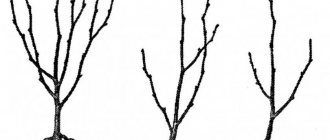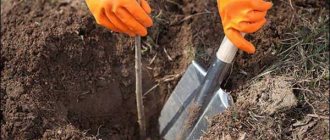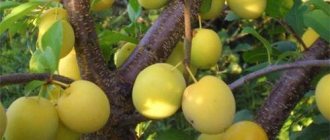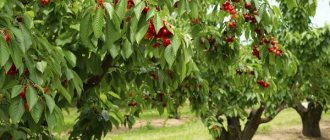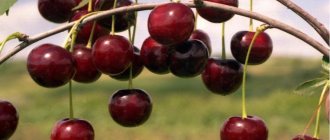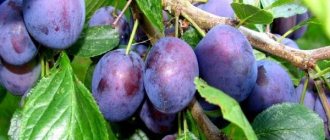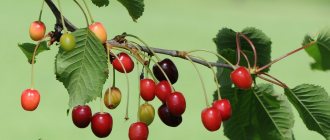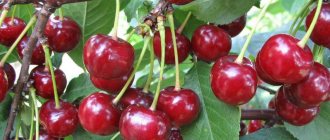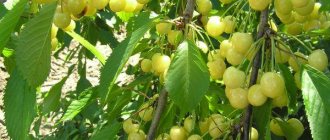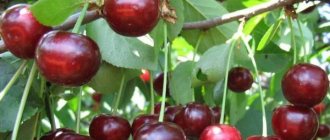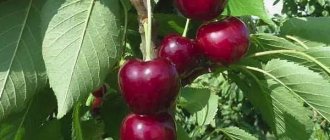History of selection
This cherry variety was bred by breeders of the Rossoshansky fruit and berry experimental station in Russia. The author of the new variety is A. Voronchikhina.
Did you know? Some types of cherries can reach gigantic sizes - over 30 meters.
The “parents” that passed on the main characteristics are Denissena yellow and Gini red. In some sources, one of the varieties is indicated as the main one, and the second - as a pollinator.
The Julia hybrid was included in the State Register in 1992 and is offered for cultivation in the territories of the following administrative units:
- Central Black Earth Region;
- Lower Volga region.
Reviews
Igor Valerievich
I became acquainted with the variety via the Internet, saw the tree during the fruiting period and became interested in it. My attention was focused on the appearance of the berries. I planted several trees on my plot. So far the yield remains average, but it is quite enough to eat fresh and for homemade preparations.
Inna Vladimirovna
Every year there are more and more berries on my tree. I liked this variety so much that I’m thinking about planting a second tree. I use cherries to make compotes, jams and preserves. The taste of the berries is simply amazing.
Description and characteristics of the variety
The Julia cherry is hard to miss. This hybrid is distinguished by its large dimensions, and this applies to both the tree and the fruit.
Tree
Powerful, fast growing. The height of adult specimens reaches eight meters or more. The crown is spreading, pyramidal, dense. The branches of the bottom row are slightly lowered. The trunk is covered with slightly rough bark, sometimes flaky and smooth. Mostly, the color of the bark is gray, with a slight cherry tint.
Did you know? There are more than a hundred varieties of cherries in the world, but about two dozen of them are grown en masse.
The branches are small, but the internodes are long. During the growing season, quite powerful buds are formed: vegetative - elongated and sharp, up to 7 mm long, generative - ovoid, up to 6 mm.
When flowering, snow-white inflorescences bloom, collected in 2-3 pieces. The foliage is ovate, pointed, with large chips along the edges and a smooth surface. The leaves are pubescent on the underside
Fruit
The ripe berries are quite large - 7-8 g. Young trees produce a harvest of smaller fruits - 5-6 g.
Cherry fruits are round or heart-shaped, slightly flattened on the sides. The skin is thin but dense, colored creamy pink. A bright blush spreads over the entire surface. It is especially expressive on the sunny side. Berries that ripen in the shade have a weaker blush.
The stone is oval, brown-yellow, small (0.45–0.5 g), making up about 9% of the total mass. Easily separates from the pulp. The peduncle is oblong, 4.1–4.8 cm long. The pulp is cream-colored, slightly fibrous, juicy, and dense. According to the characteristics of the pulp, Julia cherries belong to the bigarro group. Fresh juice has no color and is cloudy.
The taste of the fruits is practically no different from other varieties of cherries: sweet, with a slight sourness. According to tasters they deserve 4.4 points
Pollinators
Julia is a self-sterile cherry variety. To set fruit, pollinating trees are needed that bloom at approximately the same time. The following are the most suitable varieties for pollination.
Ovstuzhenka
The Ovstuzhenka cherry is low-growing, its height reaches 3 meters. The fruits ripen in mid-June. The weight of the berries is 4.2-7 grams, the color is burgundy, the taste is sweet.
And the way
The height of Iput cherry trees reaches 3.5-4.5 meters. The berries are dark red, almost black, and ripen by the end of June. Their weight is 5-9 grams, the taste is sweet, slightly tart.
Raditsa
Cherry trees of the Raditsa variety are medium-sized, their height reaches 4 meters. Fruiting begins in early June. The berries are bright ruby in color and very sweet when ripe.
Bryansk pink
The Bryansk pink cherry variety is represented by trees 2-3 meters high, blooming in May, bearing fruit in July. The berries are round, yellow-pink in color, their weight reaches 5 grams.
See also
Optimal timing for pruning cherries and methods of crown formation
Read
Note! Pollinator varieties of cherry Julia should be located at a distance of no more than 35-40 meters from it.
Advantages and disadvantages of the variety
- The main advantages of the cherry hybrid Julia are the following characteristics:
- high productivity;
- ability to withstand difficult climatic conditions;
- preservation of presentation during transportation;
- ease of care.
- Among the disadvantages, gardeners note the following:
- the presence of pollinating neighbors to increase productivity;
- the fragility of the branches, due to which the tree does not withstand wind and other physical stress (weight of the crop, etc.);
- in climate zones with “short” summers, the berries do not have time to fully ripen.
The best early varieties of cherries
Iput500 (one-year-old in a container (ZKS)) Our rating of the best varieties of cherries opens with an early variety that ripens in mid-June. Tree 4 - 6 m high. The crown is wide-pyramidal and dense. The fruits are smooth, weigh from 5 to 10 g, obtuse-heart-shaped, black-red, with dark red tender pulp of medium density, seed separation is average. The taste is juicy-sweet with sourness. Ripe fruits have an appetizing, attractive, marketable appearance. With a lack of heat and sun, the fruits acquire a tart taste and pronounced sourness. In favorable years, 25 - 35 kg are collected from one tree. The winter hardiness of this cherry variety is good, but in severe winters there is slight freezing of growth and average damage to flower buds. After returning spring frosts, no more than 60% of the ovaries are damaged. Resistant to diseases. Recommended in the Central and Central Black Earth regions. In the Moscow region, Nizhny Novgorod, Penza and Samara, gardeners note good adaptive qualities. Pollinator varieties: Revna, Tyutchevka, Bryansk pink, Ovstuzhenka and Raditsa. Main advantages:
Cons: | 9.8 / 10 Rating Reviews A good, very early variety of cherry, does not get sick. I ripen along with garden strawberries. The fruits are large, but watery and sour. |
| Chermashnaya850 (two-year-old in a container (ZKS)) Yellow-fruited cherry with early ripening. Tree 4.5 - 5 m high. The crown is spherical, raised, not thickened. The fruits are one-dimensional, smooth, round, weigh on average 4 - 4.5 g, pale yellow, with thin and dense skin. The taste is dessert, sweet with a slight sourness. The pulp is juicy and tender, yellow in color, the stone separation is good. Unfriendly maturation is observed. The average yield of an adult tree is 15 - 20 kg. The variety is absolutely self-fertile, that is, without a pollinator it will not set a single fruit. For cross-pollination, plant Fatezh, Raditsa or Bryansk pink. It is distinguished by early fruiting: fruiting begins 3–4 years after planting. The wood's winter hardiness is average; flower buds can be damaged by spring frosts. Recommended for cultivation in the Black Earth region. There is positive experience of growing in the Moscow region, but gardeners after harsh winters note the appearance of frost holes on the bark. Main advantages:
Minuses:
| 9.7 / 10 Rating Reviews A good yellow cherry, the tree is simply strewn with berries. I like the fact that when the neighbor’s red cherry tree ripens, our Chermashnaya tree does not attract starlings. |
| Ovstuzhenka420 (one-year-old with open root system) A good variety of cherries with early ripening fruits. Trees 3 - 4 m high, with a dense, raised, spherical crown. The short stature of the trees makes it easier to harvest and protects the fruits from starlings. The fruits are round, deep burgundy, weigh 4 - 7 g, the flesh is dark red. They are easily separated from the stalk, with a dry separation, the separation of the stone from the pulp is good, and does not crack. The taste is juicy and sweet, without astringency. The yield of one tree with good care and without damage is 50 - 60 kg, in the first years of fruiting - 10 - 15 kg. Partially self-fertile, therefore even without a pollinator it sets a small (about 5%) number of fruits. Pollinator varieties: Revna, Bryansk pink, Iput, Tyutchevka, Raditsa. It is characterized by high winter hardiness and frost resistance, including flower buds and ovaries. Shows high resistance to coccomycosis and moniliosis, and is moderately affected by clusterosporiasis. The variety is zoned in the Central region. There is good experience in growing in Chelyabinsk and in the Middle Zone. Main advantages:
Minuses: average fruit size | 9.7 / 10 Rating Reviews In general, we are satisfied with the variety. Good classic cherry in appearance and taste of the fruit. It doesn’t cause any problems and is always covered with berries. |
Some features of the variety
The hybrid is highly drought-resistant. It tolerates heat and short absence of moisture well.
Winter hardiness and disease resistance
The frost resistance of the tree is above average. The variety tolerates temperature drops down to -30°C well, while both the bark and root system remain unharmed.
Important! If a tree grows in a cold territorial zone, then during frosty winters most of the buds (up to 70%) die.
The Julia variety is immune to harmful insects and fungal diseases characteristic of the cherry plant. If preventive measures are carried out rationally, the risk of crop damage by coccomycosis and gray rot is minimal.
Pollinators
Sweet cherry Julia is a self-sterile hybrid. The following varieties will be good pollinating neighbors for it:
- Revna;
- And the way;
- Raditsa;
- Bryansk rose;
- Ovstuzhenka.
To achieve maximum effect, you need to plant at least three varieties of cherries on the site, the flowering phase of which coincides in time
Ripening period, yield, transportability
Cherries begin to bloom in April, and the first harvest is harvested in the fourth year after planting the seedling. If the soil is depleted and proper fertilizing was not carried out during planting, the first berries are obtained only in the fifth year of the tree’s growth. In warm regions, ripening occurs in mid-summer (June-July), in central Russia - in mid-August.
From an adult, fifteen-year-old tree, 50–65 kg of berries are collected. At a young age, such indicators are more modest - up to the age of eight, the tree produces 20–25 kg. The dense fibrous pulp of the berries allows the harvest to be transported over long distances without loss of taste and commercial characteristics.
Important! Growing in the shade greatly slows down the growth of the tree and complicates the fruiting process.
Productivity
Julia has excellent yields, but this can only be achieved gradually. In the first year after the formation of ovaries, there will be very few berries, even though the crown is already growing to its full height.
Each year the harvest will grow and can reach 25 kg per tree. A tree over 15 years old can produce up to 100 kg of cherries.
Among the positive qualities of this tree is its consistency in harvest. For example, if last year the harvest was a record one, and you didn’t know what to do with it, then this year it will be the same.
More details about the cherry variety in the video:
Preparing for landing and choosing a site
To plant the Yulia cherry variety, select a site based on the following parameters:
- Groundwater . Their proximity to the surface is undesirable, since there is a high probability of excess moisture accumulation. The optimal water level is no less than 2.5 m.
- Openness of the site . Such places create the preconditions for the negative influence of winds on the inflorescences and buds of the tree - they can be damaged by strong winds.
- Spacing between plants . Do not forget that an adult tree has a wide crown. Therefore, when planting, a free zone is left (minimum distance - 3 m).
- The soil . Suitable: light, fertile, with neutral acidity.
- Lighting . Constant access to light promotes active growth and development. It is not prohibited to plant a tree in partial shade.
Fertilizers
Although Julia is an unpretentious variety, trees cannot be left without care. Vigorous plants remove large amounts of nutrients from the soil, so fruit-bearing specimens must be fed generously. To do this, dig a groove along the perimeter of the crown, where the bulk of the suction roots are located. It is irrigated, and a fertilizer solution is already poured over the wet soil.
Nitrogen is applied in early spring so that plants have time to use it to grow foliage. The use of potassium compounds is usually timed to coincide with flowering and drupe set. And superphosphate is applied in the form of granules in the fall so that heavy rains dissolve them. The shoots are trimmed as far as possible at this height.
Landing rules
Every gardener knows that any variety should be planted in accordance with certain requirements. Grafted cuttings of Julia cherries are planted at a time when the soil has already thawed and sap flow has not yet begun (the buds have not opened).
Planting is allowed at the end of the growing season. But at the same time, the leaves are torn off, and the roots, without fail, hill up well and insulate the trunk. For spring planting, the hole is prepared in the fall. If the tree is planted in the fall, dig a hole 2-3 weeks before the planned event.
We recommend reading about the rules for planting cherry seedlings in the spring.
Before planting, the area is cleared of weeds and unnecessary items are removed. Planting work is carried out according to the following scheme:
- Preparing the pit . Dimensions: diameter - 90-100 cm, depth - 0.7 m.
- Feeding . A layer of organic fertilizers (compost, humus, manure, wood ash, potassium and phosphorus-containing substances) is placed at the bottom of the hole.
- Placement of seedling . A small hill is built in the center of the pit, placing a seedling on its surface. A peg is stuck next to the hole and the tree is fixed, tied to the peg.
- Shutdown . The seedling is sprinkled with earth, compacting the soil in such a way as to prevent voids around the rhizome. The soil is watered with two buckets of water and mulched on top (compost).
If you plan to plant several trees, leave at least 4-5 m between them, and 2-3 m between rows
How to plant cherries Julia
The place for planting Julia cherries should be selected taking into account the following conditions:
- proximity to groundwater and placement in lowlands where there is a possibility of accumulation of excess moisture is undesirable;
- the use of open areas, which creates the preconditions for the adverse effects of strong winds on tree buds;
- The wide crown of an adult plant determines a 7-meter distance to a neighboring tree.
Attention! The optimal location for Julia cherries, in the northern regions of the country, is represented by the proximity of tall buildings on their southern side.
How to choose a seedling
When choosing a seedling, pay attention to the following:
- the root system must be strong and branched;
- damage to the bark and processes is not allowed;
- the trunk and branches are elastic.
You can do without the cost of purchasing Julia cherry seedlings by growing them yourself:
- From a seed. To do this, in the fall, place a large seed from the fruit in a flower pot with a mixture of soil and sand in a 1:1 ratio. Grow at room temperature with occasional watering. In the spring, the seedlings are hardened by lowering the temperature, and when the soil warms up, they are planted in the ground.
- A piece of root. You need a root at least 30 mm thick and 200-300 mm long. Planting is carried out in a hole 200-250 mm deep and watered abundantly. When sprouts emerge, the strong ones are left, the rest are removed.
Planting dates and scheme
The Julia variety is planted both in spring and autumn. Winter frosts do not harm the plant. Before planting in the ground in the spring, it is recommended to soak the roots of the plants in water at room temperature for a period of 3 to 5 hours. They will be enriched with moisture, and growth at the initial stage will be more active.
Attention! Considering the height of the tree and the volume of the crown, the recommended planting pattern is 6x6 meters.
Pit preparation
The dimensions of the pit for Yulia cherries are 0.6×0.6×0.6 meters. When planting, the soil should be fertilized. For a hole of this size, 10 kg of compost is enough. If the soil is depleted, then add potassium sulfate and superphosphate 50/120 grams, respectively.
Landing
In a hole dug in advance, a small mound of soil is made, on which the seedling is placed. The roots are carefully straightened. To tie up the fragile trunk of the seedling, a peg is placed. Bury to the root collar with soil free of stones and clods, followed by gentle tamping. The empty depression around the trunk is used for irrigation. Immediately after planting, the soil is saturated with moisture in a volume of 10-15 liters of water.
Features of further care
Subsequent tree care includes standard agrotechnical procedures. But each of them is carried out according to certain rules.
Watering
The event is held as needed. Cherry does not tolerate either excessive moisture in the soil in which it grows or “overdried” soil. The tree must be watered abundantly in the autumn, before the winter cold. This will protect the root system from possible freezing, and therefore minimize the risk of plant death.
Feeding
The tree needs fertilizers only when the phase of abundant fruiting begins - in the fourth year of life. The following fertilizers are required for cherries:
- Nitrogen . Preparations based on it are applied during active sap flow, in March or April (depending on the region). It is important to apply such fertilizers before the flowering period, using them as tree-trunk watering. At a distance of 1.5 meters around the tree, a ditch is dug into which fertilizer is poured. The solution is prepared from chicken manure (1 kg) diluted with water (20 l). The mixture is mixed well and allowed to brew for 24 hours, stirring from time to time.
- Potassium . Potassium compounds are used during berry formation. Nutrient liquid is prepared from wood ash (300 g) and warm water (20 l). The mixture is stirred and left for 2.5–3 hours until cooled. Apply the solution to the soil “in its pure form” or during watering.
- Superphosphate . It is added to the soil before the winter period, when the tree sheds its leaves. The drug is scattered on the surface of the soil around the trunk and covered with a thin layer of earth to prevent it from being blown away by the wind. Weather precipitation will dissolve the drug, and it, together with water, will penetrate the rhizome.
Did you know? At one time, cherry resin was used as chewing gum.
Tree trunk care
The tree trunk area absolutely requires care - it is periodically cleared of weeds and fallen leaves are removed. In addition, the soil is periodically loosened. This ensures better penetration of moisture to the roots. You should not neglect mulching the tree trunk circle - it will help moisture stay in the soil longer and reduce the number of waterings.
The following materials are used as mulch:
- needles;
- compost;
- hay;
- straw;
- wood sawdust.
Mulch will protect the plant from pests and diseases, insulate the roots and eliminate the need to loosen the soil once again
Pruning and crown formation
This procedure is mandatory for the tree, especially after five years of age. It helps to increase productivity, and also facilitates the process of picking berries, eliminates thickening, development and spread of diseases.
Important! A dense crown is the main enemy of productivity. For good fruiting, the plant needs abundant sunlight.
It is recommended to prune in late fall or early winter when the tree is dormant. In spring, the damaged areas will heal and the plant will continue to actively develop. During pruning, old and damaged branches are removed, as well as dried and overgrown shoots. The main branch of the tree should protrude 20 cm above the others. When forming the crown, you should control the length of each branch.
Protection from cold and rodents
Before the onset of cold weather, the tree must be protected from frost and protected from rodent infestations. This is especially important for young plants and immature seedlings. Burlap, special non-woven material or thick polyethylene film are used as covering material.
We advise you to read about grafting sweet cherries onto cherries in spring and summer.
The insulation process is simple : pegs are driven vertically into the soil near the tree and a covering layer is pulled over them. Such a dome creates a microclimate favorable for cherries around the above-ground part of the plant. The soil near the trunk is covered with a layer of mulch for the winter. The lower part of the trunk is covered from rodents with roofing felt or metal mesh.
Subsequent care of the crop
Growing Julia cherries requires performing actions that can be safely classified as standard activities:
- The Julia cherry tree needs moderate watering. This means that it should be done as needed. Mulching helps regulate the frequency of watering.
- Feeding. Nutrition is introduced in the fall, and it must be complex - organic compounds are combined with mineral ones. In spring, cherry varieties Julia are fed with nitrogen fertilizers.
- Trimming. It is absolutely necessary, especially after the tree reaches 5 years of age. This procedure increases the yield of cherries, facilitates the process of harvesting fruits, forms the crown, and reduces the density and spread of diseases.
- Preventive treatments are carried out according to timing, and therapeutic treatments at the first signs of disease.
- Preparing for winter. Before the onset of cold weather, the bark is whitened and insulated.
Harvest and storage
At the end of June they begin to pick berries from the branches. You should not delay this work, since the branches may break under the weight of the fruit. On average, Julia cherries are stored in the refrigerator at 0°C for about two weeks.
For longer storage, berries are placed in the freezer.
As you can see, the Julia variety does not cause much trouble. And its high winter hardiness and moderate drought resistance make it possible to grow it in almost all regions of Russia.
Diseases and pests, methods of control and prevention
| Problem | How to fight |
| Coccomycosis | Spraying according to the instructions with Horus or Topaz |
| Clusterosporiasis | Removing and burning affected parts. Treatment with Horus |
| Moniliosis | Cleaning and removing diseased parts of the tree from the site. Regular implementation of measures to prevent pest attacks. Treatment of cherries with copper sulfate, Nitrafen, whitening of trunks with garden whitewash |
| Feathered pests | The use of repellent materials - tapes, rattles, sound signals |
Description of fruits
The fruits weigh about 5 g (in young trees they are larger - up to 8 g), with a diameter of about 2 cm. Round in shape, slightly flattened on the sides, the fruits have juicy fibrous pulp and are covered with a creamy-yellow skin with a pinkish blush. The taste is sweet with barely noticeable sourness.
Familiarize yourself with the agricultural technology of growing cherries of such varieties as: “Large-fruited”, “Valery Chkalov”, “Regina”, “Bull’s Heart”, “Dibera Chernaya”, “Bryanskaya Rozovaya”, “Iput”, “Fatezh” “Chermashnaya” and “Leningradskaya” black."
“Julia” is a self-sterile variety, next to which a pollinator tree should grow. Good pollinators for “Yulia” are “Revna”, “Raditsa”, “Iput” and “Ovstuzhenka”.
Important! Most cherries are self-sterile and require nearby pollinating plants. For maximum cross-pollination, you need to have at least three varieties of cherries in your garden with coinciding flowering periods
